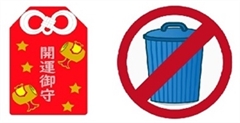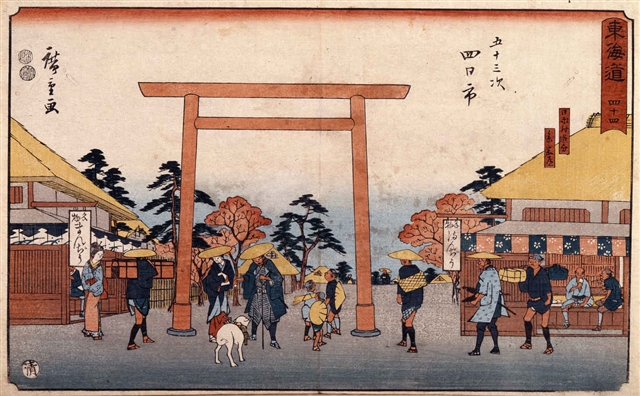God will be grieved if you throw away "Omamori"amulets like ordinary trash.

When you travel to Japan, do you visit shrines and buy amulets as souvenirs?
Do you take the omikuji or omofuda back home with you?
Such things from shrines are sacred items that should not be thrown away as garbage.
They must be disposed of in the proper way (if this is the case, it is not called disposal, but rather "return" to the gods). You have to dispose of them in the right way.
Shrine amulets are prayed for in advance at the God, so they are imbued with the vibrations of the God. The vibrations of the amulet will lose their effect after six months.
It is not a bad thing to keep it even if it has been in your possession for more than a year. It is a sacred object, so if you like it, you can keep it and treasure it.
I will return the protective amulet to the deity on your behalf.
However, even if you no longer need the amulet, you should not throw it away as garbage. Some people say, "If you sprinkle salt on it to purify it, you can throw it away as garbage," but others say that this is not acceptable.
If you are traveling and living far away from the shrine, it is difficult to return the amulet. However, there are not many shrines that accept returns by mail from outside Japan.
Therefore, for those of you outside of Japan, we will accept the disposal of old omamori (charms) and other items purchased at shrines. I will take your old money and amulets received by mail from outside Japan directly to the shrine and return them to the deity.
If you are unable to dispose of them yourself because you feel that God would be saddened, please email me. I will help you return it to God. As your proxy, I will offer it to the deity. (Proxy worship)
By the way,
In Japanese Shinto, the deities have a desire for "human happiness" and wish to grant "human desires." They are fully aware of "freedom of faith" among humans, which is why followers of other religions are welcomed without any issues.
Therefore, when individuals who follow other religions visit Japan, there is no problem with them praying for their wishes to be fulfilled at shrines or purchasing protective amulets as souvenirs.
Proxy visitation
On behalf of you, residing outside Japan, I will perform shrine visits as your proxy to fulfill various requests.
Proxy visitation means
Proxy visitation refers to conducting a visit on behalf of individuals who are unable to go to shrines or temples due to poor health or distance.
Although 'proxy visitation' may sound complicated, common scenarios include:
・Praying for the 'longevity and good health' of one's parents.
・Wishing for the 'safety of travel routes' for a friend going on a trip.
・Seeking 'success and fulfillment upon entering university' for a son preparing for the entrance exams.
・Offering prayers for the 'victory and success' of seniors or juniors in upcoming matches or competitions.
In these cases, one is not making personal requests, but rather praying for the wishes of others. This also falls under the category of 'proxy visitation'.
I would like to make a proxy visit and offer a prayer at a spiritually significant shrine or temple.
When it comes to shrines known for granting blessings of romantic fulfillment, Jishu Shrine in Kyoto Prefecture is famous. Additionally, for blessings of success in exams, Kitano Tenmangu, where Sugawara no Michizane is enshrined, is renowned.
For more unique cases, there is the Mikami Shrine, known for granting blessings to those aspiring to succeed as a Hair and Makeup Artist or to prevent hair loss.
However, there can be an issue for those coming from overseas as the desired shrines or temples may be far away. For those in such situations, we encourage you to consider using our proxy visitation service.
The History of Proxy Visitation
The History and Origins of Proxy
In ancient times, pilgrimage usually involved visiting nearby shrines and temples. However, from around the Heian period, it became common to also make pilgrimages to distant shrines and temples. Pilgrims started coming from all over the country, but traveling to distant places incurred expenses. As a result, people formed teams and pooled money to send a representative to make the pilgrimage.
Furthermore, when making a pilgrimage to Ise Grand Shrine, there was a custom known as 'nukemairi.' This tradition allowed pilgrims to continue their journey even if they ran out of money along the way, thanks to the assistance of people along the route. This was because it was believed that those who provided assistance would receive the same blessings as the pilgrims themselves.
おかげ参り(gratitude mairi) and おかげ犬(gratitude dog)
おかげ参り(gratitude mairi) refers to the collective pilgrimage to Ise Grand Shrine that took place during the Edo period. It is said that people from all over Japan made pilgrimages to Ise Grand Shrine.
Among them were many who, due to reasons such as poor health or financial constraints, could not make the pilgrimage to Ise Grand Shrine themselves. In their place, they sent a representative to make the pilgrimage on their behalf, known as the 'おかげ犬(gratitude dog).'
To ensure that everyone knew the purpose of the pilgrimage and the money required for the journey, the gratitude dog would have a sign attached to it with this information written on it. Upon reaching Ise Grand Shrine, the gratitude dog would receive a token of gratitude in a bamboo tube from the shrine priests, and then return to its owner.
The History of Proxy visitation
The history of proxy worship dates back to ancient times. In works such as "Ise Sangu Kudashi Miyagawa Ferry" and "Tokaido Gojusan Tsugi Yonmachi," both painted around 1855 by Utagawa Hiroshige, there are depictions of "okage inu" (gratitude dogs) being used as proxies for worship.

Reference:Mie Prefectural Art Museum
The Process of Proxy Visitation
Application/Request
After reviewing the pricing plans, please provide your name, selected plan, any specific requests, and your email address. I will respond via email.
Next, please proceed with the payment.
After you apply, our representative will contact you via email to the address you provided. Please review the details and proceed with the payment.
Proxy visit
Once the payment is confirmed, we will conduct the proxy visit to the shrines or temples within 7 business days. We will also inform you of the scheduled date and time for the visit, so please check and confirm it.
Once the visit is completed, we will send you a notification to your provided email address.
For any enquires please click here.
This post may contain affiliate links. Please read my disclosure policy for details. As an Amazon Associate, Google Adsense,I earn from qualifying purchases.
